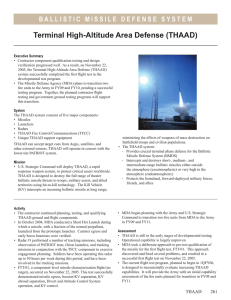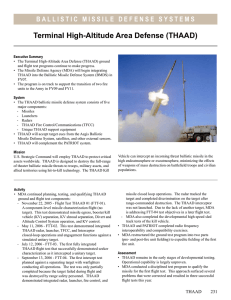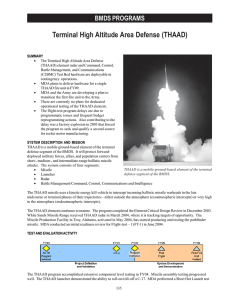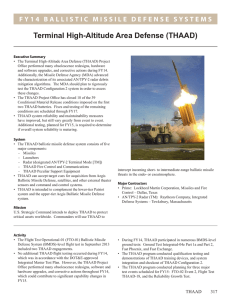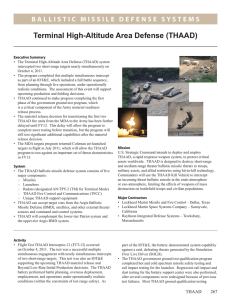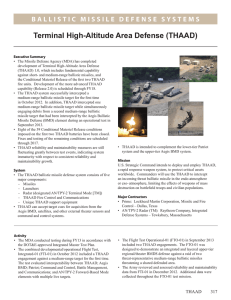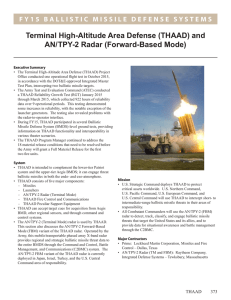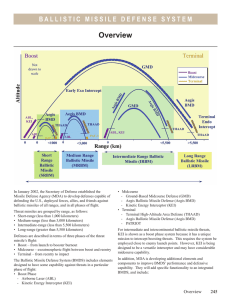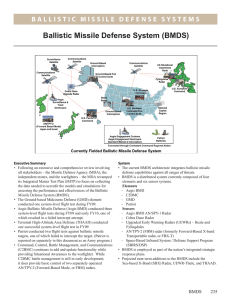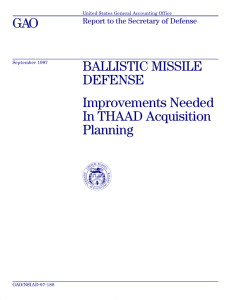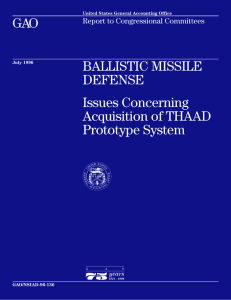Terminal High-Altitude Area Defense (THAAD)
advertisement
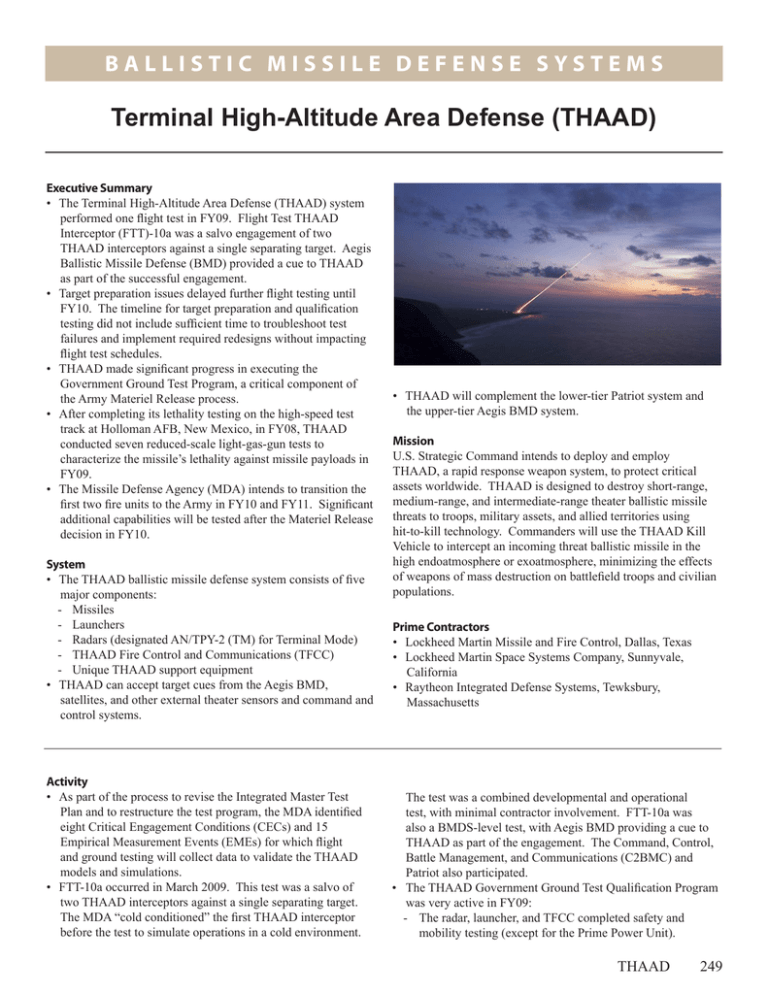
BALLIS T I C M ISSILE D EFENSE SYS T E M s Terminal High-Altitude Area Defense (THAAD) Executive Summary • The Terminal High-Altitude Area Defense (THAAD) system performed one flight test in FY09. Flight Test THAAD Interceptor (FTT)-10a was a salvo engagement of two THAAD interceptors against a single separating target. Aegis Ballistic Missile Defense (BMD) provided a cue to THAAD as part of the successful engagement. • Target preparation issues delayed further flight testing until FY10. The timeline for target preparation and qualification testing did not include sufficient time to troubleshoot test failures and implement required redesigns without impacting flight test schedules. • THAAD made significant progress in executing the Government Ground Test Program, a critical component of the Army Materiel Release process. • After completing its lethality testing on the high-speed test track at Holloman AFB, New Mexico, in FY08, THAAD conducted seven reduced-scale light-gas-gun tests to characterize the missile’s lethality against missile payloads in FY09. • The Missile Defense Agency (MDA) intends to transition the first two fire units to the Army in FY10 and FY11. Significant additional capabilities will be tested after the Materiel Release decision in FY10. System • The THAAD ballistic missile defense system consists of five major components: - Missiles - Launchers - Radars (designated AN/TPY-2 (TM) for Terminal Mode) - THAAD Fire Control and Communications (TFCC) - Unique THAAD support equipment • THAAD can accept target cues from the Aegis BMD, satellites, and other external theater sensors and command and control systems. Activity • As part of the process to revise the Integrated Master Test Plan and to restructure the test program, the MDA identified eight Critical Engagement Conditions (CECs) and 15 Empirical Measurement Events (EMEs) for which flight and ground testing will collect data to validate the THAAD models and simulations. • FTT-10a occurred in March 2009. This test was a salvo of two THAAD interceptors against a single separating target. The MDA “cold conditioned” the first THAAD interceptor before the test to simulate operations in a cold environment. • THAAD will complement the lower-tier Patriot system and the upper-tier Aegis BMD system. Mission U.S. Strategic Command intends to deploy and employ THAAD, a rapid response weapon system, to protect critical assets worldwide. THAAD is designed to destroy short-range, medium-range, and intermediate-range theater ballistic missile threats to troops, military assets, and allied territories using hit-to-kill technology. Commanders will use the THAAD Kill Vehicle to intercept an incoming threat ballistic missile in the high endoatmosphere or exoatmosphere, minimizing the effects of weapons of mass destruction on battlefield troops and civilian populations. Prime Contractors • Lockheed Martin Missile and Fire Control, Dallas, Texas • Lockheed Martin Space Systems Company, Sunnyvale, California • Raytheon Integrated Defense Systems, Tewksbury, Massachusetts The test was a combined developmental and operational test, with minimal contractor involvement. FTT-10a was also a BMDS-level test, with Aegis BMD providing a cue to THAAD as part of the engagement. The Command, Control, Battle Management, and Communications (C2BMC) and Patriot also participated. • The THAAD Government Ground Test Qualification Program was very active in FY09: - The radar, launcher, and TFCC completed safety and mobility testing (except for the Prime Power Unit). THAAD 249 BALLIS T I C M ISSILE D EFENSE SYS T E M S - Electromagnetic-environmental-effects testing began for the missile, launcher, and TFCC. - The THAAD missile completed fast cook off and 40 foot drop insensitive munitions testing. - The full THAAD system began natural environments testing at the McKinley Climatic Laboratory at Eglin AFB, Florida. - Following new equipment training, the Soldiers conducted a maintainability demonstration. • THAAD conducted seven 40-percent-scale light-gas-gun lethality tests using high-fidelity surrogate payloads between March and September 2009. • THAAD participated in Ground Test Distributed-03 (GTD-03) in March 2009 using hardware-in-the-loop to demonstrate interoperability with other BMDS components. • THAAD also participated in the “Caravan 2” U.S. Flight Test-3 in July 2009. An AN/TPY-2 (TM) radar tracked the target, and TFCC forwarded tracks to C2BMC. Assessment • THAAD made significant progress in FY09, with the first demonstration of a salvo intercept and cueing from Aegis BMD during a successful live engagement in FTT-10a. • The program also expanded operational realism during FTT‑10a, which was a combined developmental and operational test. Soldiers operated the equipment and used operational tactics, techniques, and procedures. There was minimal contractor support. The test also demonstrated communication links between THAAD, Aegis BMD, C2BMC, the Pacific Command Joint Operations Center, the Pacific Air Operations Center, and the 94th Air and Missile Defense Command. 250 THAAD • The THAAD light-gas-gun tests provided data on the missile’s lethality against two types of threat missile payloads, which the MDA will use to support the lethality evaluation and to validate lethality modeling and simulations. The MDA must analyze and understand the significance of some test results that did not match pre-test predictions. Less than optimum test results combined with deficiencies in lethality models may affect the final lethality assessment. • Target availability continues to challenge the THAAD program schedule. During qualification and integration testing, targets for two upcoming flight tests experienced problems forcing delays in the flight test dates. One target required redesign and retesting of the Avionics Power Assembly. Another target experienced radio frequency interference requiring redesign and retesting of the L-band transmitter. • The MDA plans additional THAAD testing after the Materiel Release Review Board scheduled for 4QFY10. Specifically, it plans to conduct flight testing against longer-range targets. The expanded capabilities inherent in the THAAD design will not be confirmed by testing before delivery of the two fire units to the warfighter. Recommendations • Status of Previous Recommendations. The MDA satisfactorily addressed the one previous recommendation. • FY09 Recommendation. 1. The THAAD program should review the results of the completed lethality light-gas gun and sled testing to assure the data it collected adequately supports the completion of the current LFT&E program.
